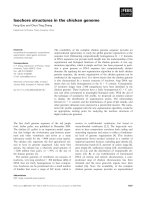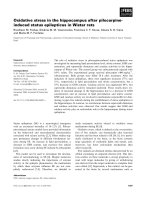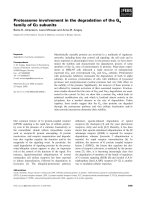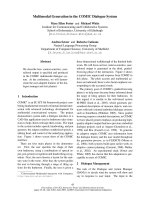Báo cáo khoa học: "Proanthocyanic polymorphism in holm oak (Quercus ilex L) in the Mediterranean region of France" pps
Bạn đang xem bản rút gọn của tài liệu. Xem và tải ngay bản đầy đủ của tài liệu tại đây (406.58 KB, 9 trang )
Original
article
Proanthocyanic
polymorphism
in
holm
oak
(Quercus
ilex L)
in
the
Mediterranean
region
of
France
P
Lebreton
M
Barbero
2
S Nader
1
Laboratoire
de
biochimie
végétale,
Université
Lyon-1,
43,
boulevard du
11
novembre
1918,
F-69622
Villeurbanne
Cedex;
2
Laboratoire
de
botanique
et
d’écologie
Méditerranéenne,
faculté
des
sciences
de
Saint-Jérôme,
rue
H
Poincaré,
13397
Marseille
Cedex,
France
Summary —
We
studied the
proanthocyanic
diversity
of
holm
oak
in
France.
The
percentage
of
pro-
delphinidin
remains
constant
for
each
individual
tree,
independent
of
age
or
location
of
the
leaves.
By
contrast,
this
content
can
be
significantly
different
between
trees
within
the
same
population.
An
in-depth
analysis
of
a
Languedocian
population
showed
a
good
relationship
between
observed
and
predicted
sample
structure,
according
to
the
hypothesis
of
2
alleles,
prodelphinidin
’weak’
and
’strong’,
respectively,
governing
the
biosynthesis
of
this
polyphenol.
We
have
probably
observed
a
biochemical
polymorphism
comparable
to
that
previously
demonstrated
for
several
coniferous
spe-
cies.
holm
oak
/
prodelphinidin
/
polymorphism
Résumé —
Polymorphisme
proanthocyanique
du
chêne
vert
Quercus
ilex
L
dans
la
région
méditerranéenne
française.
La
diversité
proanthocyanique
d’une
population
languedocienne
de
chêne
vert
Quercus
ilex
a
été
étudiée.
La
teneur
foliaire
relative
en
prodelphinidine
est
constante
pour
un
individu,
indépendamment
de
son
âge
et
de
la
situation
des
feuilles;
elle
peut
par
contre
dif-
férer
significativement
entre
arbres
de
la
même
population.
Une
analyse
détaillée
montre
une
bonne
corrélation
entre
effectifs
observés,
et
ceux
calculés
conformément
à
l’hypothèse
de
l’existence
de
2
allèles,
respectivement
«faible»
et
«fort»,
gouvernant
la
synthèse
de
la
prodelphinidine.
Il
s’agit
donc
probablement
ici
de
polymorphisme
biochimique,
analogue
à
celui
déjà
mis
en
évidence
chez
plu-
sieurs
conifères
à
l’aide
du
même
marqueur
phénolique.
chêne
vert
/ prodelphinidine
/ polymorphisme
INTRODUCTION
The
holm
oak
Quercus
ilex
L
is
the
most
prevalent
and
characteristic
preforest
and
forest
species
in
the
western
Mediterrane-
an
basin.
The
species
has
a
large
geo-
graphical
range
from
Morocco
(where
it
is
very
widespread)
to
Turkey
(where
its
presence
is
more
fragmentary).
The
holm
oak
in
France
has
penetrated
northwards
to
above
the
45th
parallel,
to
the
Vendée
and
the
southern
extremity
of
the
Dombes
(Ain).
Its
ecological
adaptability
is
also
note-
worthy,
as
the
species
can
be
found
from
the
edge
of
the
sea,
on
the
northern
side
of
the
Mediterranean,
up
to
an
altitude
of
2
500-2
600
m
in
the
Atlas
Mountains
(Barbero
et
al,
1992).
It
grows
in
temper-
ate
to
very
cold
Mediterranean
bioclimates
between
the
semi-arid
and
the
damp,
one.
The
species
grows
equally
well
on
lime-
stone
or
siliceous
soils,
though
this
adapt-
ability
cannot
be
clearly
linked
to
any
ecophysiological
or
morphological
charac-
teristics
of
the
populations
concerned.
Q
ilex
participates
in
the
structure
of
nu-
merous
potential
vegetational
series
repre-
sented
by
pre-steppe
or
forest
structures.
By
contrast,
the
numerous
preforest
land-
scapes
composed
of
holm
oak
are
an
ex-
pression
of
the
anthropogenic
constraints
of
the
agro-sylvo-pasture
systems
in
which
it
is
involved.
Moreover,
this
species
pos-
sesses
considerable
morphological
vari-
ability
as
regards
its
leaves,
to
such
an
ex-
tent
that
there
are
occasionally
more
differences
within
a
given
individual
than
between
close
neighbors
or
even
between
distinct
populations.
Such
variability
has
an
obvious
impact
on
the
systematics
of
holm
oak,
consid-
ered
by
some
authors
as
a
specific
large
taxon
and
by
others
as
being
organized
into
several
entities,
the
2
most
important
being
Quercus
rotundifolia
in
the
western
part
of
the
area,
and
Quercus
ilex
ss
in
the
eastern
part,
between
Italy
and
Turkey.
Because
of
the
above
ecological
and
biological
particularities
of
holm
oak,
we
considered
it
of interest
to
investigate
to
what
extent
proanthocyanic
’marking’ -
the
systematic
use
of
which
has
thrown
light
on
several
conifers -
was
able
to
help
clar-
ify
such
a
complex
situation,
through
a
more
objective
expression
of
the
biological
diversity
of
this
species.
The
data
present-
ed
here
are
taken from
Nader
(1990).
MATERIALS
AND
METHODS
Sampling
strategy
Forty-four
specimens
were
taken
from
1
popula-
tion
at
Valliguières
(Gard)
in
the
French
Mediter-
ranean
zone
of
holm
oak.
The
sampling
strategy
was
based
on
spatial
and
temporal
parameters.
Spatial
parameters
Bioclimatic
parameters
were
evaluated
indirectly
by
analyzing
the
significant
floristic
complex
growing
alongside
the
holm
oak.
The
Valli-
guières
population
is
located
at
the
top
of
the
meso
Mediterranean
level
and
can
even
reach
the
base
of
the
upper
Mediterranean;
Buxus
sempervirens
and
Coronilla
emerus
are
com-
mon
here.
Edaphic
parameters
revealed
com-
pact
and
dolomitic
limestone.
Analyses
were
performed
on
samples
from
neighboring
individ-
uals
(A,
B
and
C);
the
samples
were
taken
at
dif-
ferent
heights
of
the
same
tree
or
taken
in
isola-
tion
in
relatively
clear
or
densely
wooded
areas.
The
effects
of
the
organization
and
spatial-
temporal
evolution
of
populations
on
the
bio-
chemical
structure
of
individuals
is
described
elsewhere
(Barbero
et
al,
1991).
Temporal
parameters
The
hypothesis
that
the
biochemical
structure
of
adult
leaves
varies
with
the
season
was
also
tested
by
taking
samples
from
3
individuals:
A,
B and
C,
during
different
seasons
from
the
sum-
mer
of
1985
to
the
autumn
of
1986
inclusive.
In
addition,
young
and
old
leaves
were
compared
in
16
individuals,
to
evaluate
any
differences
in
proanthocyanic
composition.
Biochemical
aspects
The
leaves
of
holm
oak
always
contain
the
2
proanthocyanidins:
procyanidin
and
prodelphini-
din,
but
in
variable
absolute
(mg/g)
and
relative
(%)
quantities
depending
on
the
specimen
(the
second
molecule
differs
from
the
first
only
by
the
presence
of
a
supplementary
vicinal
hydroxyl
group
on
the
lateral
phenyl
ring.
The
analytical
technique,
based
on
treatment
with
hot
hydro-
chloric
acid
followed
by
visible
photometry
then
high-performance
liquid
chromatography,
is
de-
scribed
in
detail
elsewhere
(Nader,
1990)).
Stud-
ied
separately
at
other
French
sites,
this
vari-
ability
was
shown
to
be
comparable
in
all
cases,
and
therefore
characterizes
the
Q
ilex
species
considered
globally
in
the
biogeographic
zone
concerned.
In
the
Valliguières
population,
mean
values
were
3.88
mg/g
(n
=
41
individuals;
stan-
dard
deviation
0.48
mg/g)
for
the
proanthocyan-
ic
pool,
and
39%
(standard
deviation
14%)
for
relative
prodelphinidin
content;
extreme
values
were
2.30
and
4.25
mg/g,
20
and
68%,
respec-
tively.
The
in-depth
investigation
of
3
individuals,
A,
B and
C,
showed
that
proanthocyanic
composi-
tion
was
quite
independent
of
the
height
at
which
leaf
samples
were
taken
in
the
tree
(table
I).
The
difference
noted
between
high
and
low
leaves
for
a
given
individual
was
virtually
zero,
less
than
the
deviation
of
the
biochemical
assay
technique
(A:
+
0.04
±
0.23
mg/g;
B:
+0.08
±
0.20
mg/g;
C:
+0.01
±
0.20
mg/g).
Total
levels
of
proanthocyanins
in
adult
leaves
(>
5
months)
from
these
same
individuals
were
also
found
to
be
practically
constant
(<
±
10%),
as
shown
by
the
mean
values
of
11
sam-
ples
taken
between
5
August,
1985
and
24
De-
cember,
1986
(A:
3.30
±
0.32
mg/g;
B:
3.22
±
0.27
mg/g;
C:
3.40
±
0.21
mg/g).
The
results
were
even
more
demonstrative
as
regards
rela-
tive
prodelphinidin
content
(A:
41
±
2%;
B:
52
±
2%; C: 20 ± 1%).
However,
when
data
were
grouped
for
each
season,
absolute
values
were
seen
to
be
slightly
lower
in
winter
(table
II,
fig
1).
In
addition,
more
pronounced
differences
were
noted
between
young
(<
4
months)
and
adult
leaves
from
the
same
individual.
The
former
were
shown
to
con-
tain
markedly
lower
levels
of
total
proanthocya-
nin
and
a
little
more
relative
prodelphinidin,
re-
sulting
from
active
biosynthesis
during
foliar
ontogenesis
(table
III,
fig
2).
In
conclusion,
the
proanthocyanic
composi-
tion
of
holm
oak
leaves
is
an
individual
charac-
teristic
which
is
dependent,
to
a
secondary
de-
gree,
on
seasonal
ontogenesis.
Nevertheless,
the
relative
level
of
prodelphinidin
(LD
%)
ap-
pears
to
be
a
particularly
reliable
and
sensitive
marker
in
adult
leaves,
where
it
has
been
shown
to
be
independent
of
the
morphological
height
and
the
date
the
sample
was
taken.
It
is
there-
fore
quite
possible
to
describe
each
individual
by
a
small
number,
even
a
single
biochemical
analysis,
independent
of
the
weight
and
dryness
of
the
sample.
POPULATION
ANALYSIS
Values
for
the
LD%
marker
in
the
3
individ-
uals
A,
B and
C,
at
Valliguières
(see
table
II)
enable
us
to
differentiate
between
the
3
individuals
without
any
ambiguity,
and
are
probably
the
expression
of
biochemical
polymorphism.
The
study
of
the
38
other
individuals
in
the
same
population
has
con-
firmed
the
diagnosis
and
yielded
further
details.
It
would
seem
permissible
to
subdi-
vide
the
population
into
3
subsets:
I,
II
and
III,
with
limits
of
<
31,
31-46,
and
> 47%
prodelphinidin
content.
The
frequency
his-
togram
(fig
3)
and
the
proanthocyanic
plane
LD/LC
(mg/g)
(fig
4)
illustrate
this
point.
The
number
of
individuals
within
the
limits
of
each
subset
is
10,
19
and
12
(24,
46
and
29%
of
the
total,
respectively).
Proanthocyanic
polymorphism
of
the
holm
oak
therefore
appears
to
be
struc-
tured,
and
we
can
put
forward
the
hypothe-
sis
of
a
genetic
model
in
conformity
with
that
demonstrated
for
the
same
prodel-
phinidin
marker
in
Juniperus
thurifera
(Gauquelin
et al,
1988)
and
in
J oxycedrus
(Lebreton
et al,
1991).
The
results
suggest
that
the
gene(s)
governing
the
synthesis
of
this
molecule
is
present
as
2
alleles,
pro-
delphinidin
’weak’
d
(<
31%)
and
’strong’
D
(>
47%),
explaining
the
appearance -
in
the
panmictic
hypothesis -
of
3
pheno-
types
dd,
dD
and
DD
whose
numbers
should
conform
with
the
well
known
Har-
dy-Weinberg
binomial
formula.
The
conformity
between
observed
and
calculated
sample
structures
(table
IV)
seems
sufficiently
good
to
accept
the
im-
plicit
genetic
model.
The
allelic
frequency
obtained
(p(d)
=
0.48)
suggests
a
process
of
hybridization,
virtually
equilibrated
in
this
population.
It
should
be
noted
that
this
bio-
chemical
polymorphism
cannot
be
directly
linked
to
the
morphological
’polymorphism’
of
the
leaves
of
the
same
individuals.
GENERAL
DISCUSSION
The
ubiquitous
nature
and
variability
of
the
holm
oak
are
such
that
considerable
research
has
been
performed
in
the
hope
of
establishing
a
realistic
and
convenient
taxonomy.
The
populations
in
France
are
even
more
interesting
in
that,
for
biogeo-
graphers
and
ecologists,
they
are
derived
from
the
hybridization
of
the
2
eastern
(Q
ilex
ss)
and
western
(Q
rotundifolia)
taxa,
which
only
accentuates
the
biologi-
cal
and
systematic
complexity
of
the
question.
Madjidieh (1982)
used
morphological
data
(including
foliar
surface
indices),
col-
lected
from
the
whole
western
Mediterra-
nean
area,
to
establish
that
the
popula-
tions
of
holm
oak
present
notable
differences,
though
no
abrupt
discontinui-
ties
are
apparent.
The
south
of
France
is
the
site
of
extreme
types:
Q
ilex
and
Q
ro-
tundifolia,
but
with
a
continuum
of
interme-
diary
types.
Q
ilex
ss
is
more
frequently
found
on
siliceous
soils
(north-facing
slopes,
deep
soil),
whereas
Q
rotundifolia
type
seems
to
be
dominant
on
limestone
substrates
(zones
of
summer
hydric
stress)
(Madjidieh,
1987).
From
a
biochemical
point
of
view,
Ya-
cine
(1987)
used
alloenzyme
frequencies
to
show
the
differentiation
(unsuspected
by
biometrics)
between
Italian
and
Spanish
populations.
Similarly,
Afzal-Rafii
(1988)
used
electrophoretic
analysis
of
isoen-
zymes
(13
peroxidase
bands
demonstrat-
ed)
to
show
a
possible
distinction
between
Spanish
and
Italian
populations;
the
latter
appear
to
be
more
homogeneous
from
a
foliar
biometrics
point
of
view.
The
lipid
composition
of
the
acorns
has
also
been
envisaged
as
an
aid
in
the
systematics
of
holm
oak
(Pelleau,
1984;
Rafii
et al,
1991).
Already
demonstrated
by
Touati
(1985),
the
variability
of
holm
oak
polyphenols
completes
the
picture,
especially
since
it
seems
to
be
the
expression
of
genetically
determined
polymorphism.
Moreover,
this
variability
can
be
brought
to
light
using
very
simple
methods
of
sampling
and
bio-
chemical
analysis,
which
could,
therefore,
be
applied
in
a
large
ecogeographic
sweep.
As
with
other
lignous
species
whose
prolonged
period
of
immaturity
ren-
ders
classical
genetic
experiments
very
dif-
ficult,
early
biochemical
diagnosis
can
be
considered
a
particularly
realistic
alterna-
tive.
results,
however,
are
currently
limit-
ed
to
French
sites,
and
therefore
possess
a
preliminary
character
that
should
prelude
further
research
in
an
attempt
to:
1)
test
the
biochemical
and
genetic
model
proposed
here
on
other
populations;
2)
test
the
useful-
ness
of
the
prodelphinidin
marker
(very
ef-
fective
in
conifers)
in
biogeographical
stud-
ies
throughout
the
whole
area
of
the
species
considered;
3)
search
for
correlations
be-
tween
other
biochemical
and/or
morphologi-
cal
characteristics,
in
order
to
establish
a
synthetic
expression
describing
the
general
polymorphism
of
this
taxon;
4)
describe
in
systematic
terms
the
reality
of
this
polymor-
phism
in
order
to
define
reliable
taxonomic
entities
which
could
be used
for
biogeo-
graphical
and
phytoecological
purposes
and,
in
general,
contribute
to
the
establish-
ment
of
a
modern
biosystematic
of
oaks.
Again,
very
generally,
these
approaches
should
contribute
to
a
reduction
in
the
diffi-
culties
met
in
characterizing
polymorphic
species
within
the
entire
Quercus
genus.
REFERENCES
Afzal-Rafii
Z
(1988)
Caractéristiques
taxono-
miques,
morphologiques
et
isoenzymatiques
du
complexe
chêne
vert.
Bull
Soc
Bot
Fr
Lett
Bot
135,
343-352
Barbero
M,
Hubert
B,
Lebreton
P,
Nader
S,
Quezel
P
(1991)
Phenological
and
ecological
variations
in
the
biochemical
composition
of
some
Mediterranean
woody
species.
Com-
mun
no
266,
IVth
International
Rangeland
Congress.
Montpellier,
22-26
Apr
1991
Barbero
M,
Loisel
R,
Quezel
P
(1992)
Biogeo-
graphy,
ecology
and
history
of
Quercus
ilex
ecosystems
in
Mediterranean
region.
Vegeta-
tio
99-100, 14-19
Gauquelin
T,
Idrissi
Hassani
M,
Lebreton
P
(1988)
Le
Genévrier
thurifère
Juniperus
thu-
rifera
L
(Cupressacées) :
analyse
biomé-
trique
et
biochimique;
propositions
systéma-
tiques.
Ecol Mediterr XIV,
31-42
Lebreton
P,
Bayet
C,
Muracciole
M
(1991)
Le
statut
systématique
du
Genévrier
oxycèdre
Juniperus
oxycedrus
L
(Cupressacées) :
une
contribution
d’ordre
biochimique
et
biomé-
trique.
Lazaroa
(Spain)
12, 21-42
Madjidieh
H
(1982)
Contribution
à l’étude
taxo-
nomique
du
chêne
vert
(Q
ilex
L)
dans
le
sud-est
de
la
France.
Doctoral
dissert,
3e
cy-
cle,
Univ
Aix-Marseille
III
Madjidieh
H
(1987)
Caractéristiques
biomé-
triques
et
optiques
de
Quercus
ilex
L
dans
les
différentes
stations
écologiques
du
sud-
est
méditerranéen
français
(Var).
Doctoral
thesis,
Univ
Aix-Marseille
III
Nader
S
(1990)
Contribution
à
l’étude
structurale
des
phytocénoses
ligneuses
méditerra-
néennes :
aspects
écologiques
et
biochi-
miques.
Thesis
Univ
Aix-Marseille
III
Pelleau
Y
(1984)
Contribution
à
l’étude
chimio-
taxonomique
du
complexe
Quercus
ilex
L
et
Quercus
rotundifolia
Lamk.
DEA
thesis,
Univ
Aix-Marseille III
Rafii
AZ,
Zavarin
E,
Pelleau
Y
(1991)
Chemo-
systematic
differentiation
of
Quercus
ilex
L
and
Q
rotundifolia
Lam
based
on
acorn
fatty
acids.
Biochem
Syst
Ecol 19,
163-166
Touati
D
(1985)
Contribution
à
la
connaissance
du
profil
biochimique
des
dicotylédones
buis-
sonnantes
et
arbustives
de
Méditerranée.
Doctoral
thesis,
3e
cycle,
Univ
Lyon-I
Yacine
A
(1987)
Une
étude
d’organisation
de
la
diversité
génétique
inter-
et
intra-
populationnelle
chez
le
chêne
vert
(Quercus
ilex
L).
Doctoral
thesis,
3e
cycle,
Univ
Sci
Tech, Languedoc









